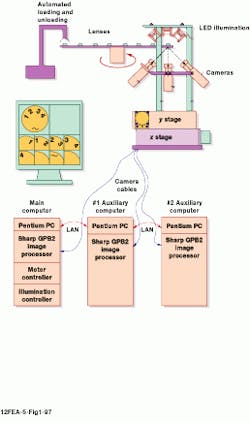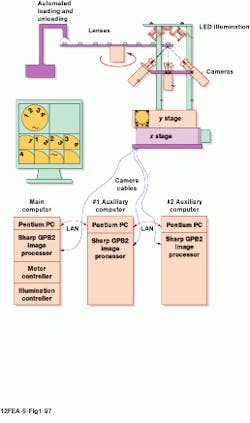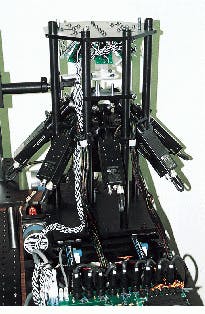Imaging components team with neural networks to inspect lenses
Imaging components team with neural networks to inspect lenses
By Lawrence J. Curran, Contributing Editor
In the past, manual inspection of lenses by skilled operators was slow and inconsistent. But, by capturing the expertise of a skilled operator and embedding it in neural-network software, Volution Inc. (San Diego, CA) has developed an automated system dubbed the ALIS 9000. Designed to inspect clear molded or machined parts, LCD panels, lenses, and transparent components for surface and edge defects, the system is faster than a human inspector, says Charles Slemon, Volution`s founder and president.
But the customer is more concerned with consistency than with blazing speed. "It`s essential to ensure that parts passed as good parts are good parts. You cannot guarantee that with a human inspector," he says. Parts being inspected are curved, transparent lenses that are examined for cracks and other defects that must be distinguished in the presence of dirt and lint on a production line.
Combining off-the-shelf illumination and imaging hardware, along with networked processor hardware and software, the ALIS 9000 system comprises cameras, LED lighting, image-processing boards, x-y positioning motors, and controllers (see Fig. 1). Combining this with a proprietary illumination/imaging subsystem and neural-network image-processing software allows the system to perform like a human inspector, says Slemon.
Transmissive imaging through transparent parts is difficult because of light refraction effects, focusing problems, and low-contrast and nonuniform illumination, explains Slemon. Because of this, the system was designed with an illumination/imaging system that is insensitive to focusing, automatically corrects for irregular illumination, and can be adjusted to enhance image contrast.
Visible-emitting red LEDs from Lite-On Optoelectronics Division (Milpitas, CA) provide the source for the system`s illumination. To image a lens, the imaging subsystem may include up to nine camera heads. At present, the system uses CCD cameras from Toshiba but can accommodate any CCD camera, Slemon says.
To perform image-processing function on captured images, the system uses the GPB-2, a PC-based image-processing board from Sharp Digital Information Products (Irvine, CA). The GPB-2 performs imaging functions, such as convolutions over a 512 ¥ 512 ¥ 8-bit image, in 12 ms using proprietary on-board ASICs. Housed in a Pentium PC-based host, the ALIS system can accommodate up to nine parallel-processing GPB-2 boards.
At the heart of the ALIS system lies intelligent image-processing software that discriminates features in the lenses, such as holes, curves, edges, alignment markings and lettering, and gradients in their transmissive characteristics. The system also detects defects, such as cracks, chips, bubbles, mold flash, and gouges -- all in the presence of dirt and lint that may not affect lens quality but must be evaluated. Imaging the lenses "is not a trivial task," Slemon stresses, but a combination of algorithmic and neural- network software differentiates between acceptable features and defects, classifies the types of defects, and logs results in a database.
James Frandsen, imaging-system engineer at Volution, says that in a typical application, 50 lenses can be mounted on a rotating wheel, and the ALIS 9000 moved on an x-y positioning table over the first lens to be inspected. There, one camera takes the first of 10 images. Because the illumination modules are mounted opposite their respective cameras, the visible LED light passes through the part to be inspected.
The initial image locates the lens being inspected, centering the optical axis to an accuracy of 1-mil. Another image is taken along this axis, and eight other overlapping "pie slices" are made by other cameras at angles of 45. Because the system requires 1.5 s
to capture and process an image, the total time taken to image a lens is 15 s when using a single GPB-2 image processor. For customers that require faster cycle times, such as five seconds, three image processors can be used in parallel. Image processing is completed while the rotating wheel moves another lens into position to be inspected. The parts fall into three categories -- pass, fail, or don`t know. Lens makers discard those in the latter category, along with the failures.
Image-processing software is crucial to determining which parts pass or fail. Most functions such as the image convolutions, filtering, and thresholding required for object identification, feature vector generation, and quantitative comparison require algorithmic processing. Standard statistical analysis is then applied to those features that are clearly understood (see Fig. 2).
For those features not easily described analytically, neural-network processing comes into play. This software evaluates a questionable feature of the lens being inspected based on the "experience" gained from stored images to determine the nature of the feature before ALIS makes the pass, fail, or don`t know determination for that lens.
Before the neural-network software was finalized, hours of manual inspection by an expert were captured and coded into the system. "It`s crucial that ALIS be trained before the system can discriminate between a defect and harmless lint," says Frandsen.
To train the system, Volution`s customer had to use ALIS to capture images and assess them manually using a trained operator on the production line, Slemon says. The skilled human inspector stored his expert knowledge of the images he viewed on magneto-optical disks, which Volution used to train the system. "It`s time-consuming," Slemon says; "ninety percent of the neural-network development effort is data collection."
When detecting a lens crack, the image taken over the lens may show very little detail because most cracks have zero width, Frandsen says. But off-angle images begin to show such defects. Using image-to-image correlation of the lens being inspected, and comparing those images with those from the training set, the software determines that the feature is a crack, and the system fails that part.
In the same manner, the software can assess a designed-in feature, such as a part number that has been laser-scribed onto the lens. If the entire number is captured in one image, but only part of it appears in the corresponding location in the following image, the neural-network software passes the part because it has already been identified as a deliberate marking (see Fig. 3 on p. 26).
Production proven
ALIS 9000 systems have been working in production lines for two years in the United States and England in both fully automated robotic-loaded and manually loaded configurations. The computerized analysis in both modes is completely automated. ALIS 9000 is priced from $70,000 to $120,000, depending on the configuration. A single system acquires and processes 10 images in 15 s. That cycle can be cut to 1 s by adding boards. As many as three GPB-2 processing boards have been networked together, communicating over a LAN from Artisoft Inc. (Tucson, AZ).
A digital I/O card from Computer Boards Inc. (Mansfield, MA) controls illumination and camera selection. The system comes with a multiplexer module that individually controls and switches among nine cameras, and any of the multiplexer channels can access other multiplexer modules.
Slemon points out that the ALIS 9000 is Volution`s first image-analysis product, but the company has been making Expert Sensors since 1987. Expert Sensors combine the output data from an array of sensors, often of different types, and process the data using algorithmic and artificial intelligence-type techniques.
FIGURE 1. Volution`s ALIS 9000 inspection system uses red visible LED lighting in a proprietary illumination system to inspect lenses. The system accommodates up to nine CCD cameras that are driven by a PC-based computer. Image- processing boards and neural-network software combine to determine whether lenses pass or fail. The ALIS system is configured to inspect lenses on a production line (inset).


